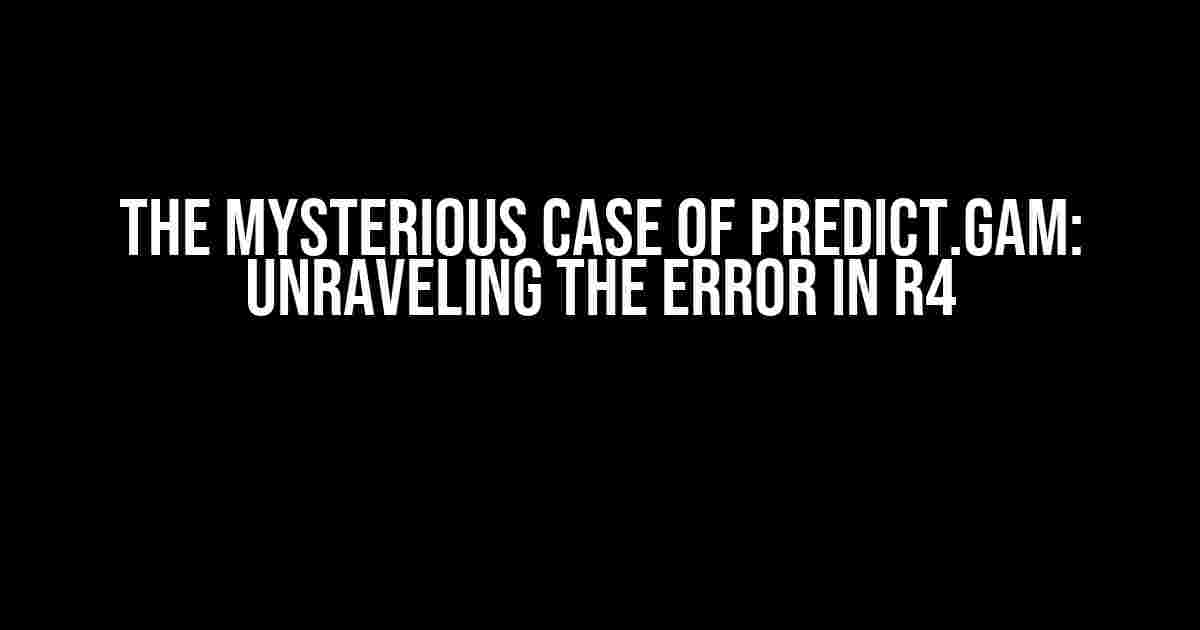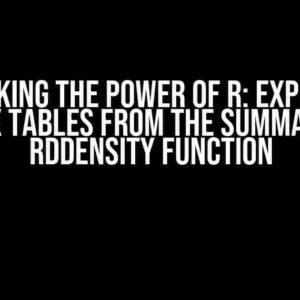If you’re an R enthusiast, you’ve probably stumbled upon the `predict.gam` function, a powerful tool for making predictions with generalized additive models. However, have you ever encountered an error when using `predict.gam` in R4, only to find that it works seamlessly in R3? You’re not alone! In this article, we’ll delve into the mystery behind this error and provide a comprehensive guide to resolving it.
The Error: A Closer Look
Before we dive into the solution, let’s take a closer look at the error message:
R4:
> predict.gam(mod, newdata = newdata)
Error in predict.gam(mod, newdata = newdata) :
'newdata' had 1000 rows but variables found have 1002 rows
R3:
> predict.gam(mod, newdata = newdata)
[works as expected]
In R4, the error message indicates that the `newdata` argument has 1000 rows, but the variables found have 1002 rows. This discrepancy is causing the error. In contrast, R3 executes the same code without any issues.
The Culprit: Changes in R4
So, what’s changed in R4 that’s causing this error? The answer lies in the updated `terms` function, which is used internally by `predict.gam`. In R4, the `terms` function returns a `formula` object instead of a `terms` object, as it did in R3.
This change affects how `predict.gam` handles the `newdata` argument, leading to the error we observed.
The Solution: A Step-by-Step Guide
Fear not, dear R enthusiast! We’ve got you covered. To resolve the error, follow these steps:
-
Update your R version to the latest release (if you haven’t already).
-
Install and load the
gampackage. -
Fit your generalized additive model using the
gamfunction. -
Create a new data frame for making predictions (
newdata). -
Use the
predict.gamfunction with thenewdataargument, but with a twist! Instead of passing the entirenewdataframe, extract the relevant columns using the[}operator or theselectfunction from thedplyrpackage.
Here’s some sample code to get you started:
library(gam)
library(dplyr)
# Fit the gam model
mod <- gam(y ~ s(x), data = train_data)
# Create a new data frame for predictions
newdata <- data.frame(x = seq(1, 100, by = 1))
# Extract the relevant columns for prediction
newdata_pred <- newdata %>%
select(x)
# Make predictions using predict.gam
pred <- predict.gam(mod, newdata = newdata_pred)
By following these steps, you should be able to resolve the error and successfully use `predict.gam` in R4.
Troubleshooting Tips
If you’re still encountering issues, here are some additional tips to help you troubleshoot:
-
Verify that your R version is up-to-date.
-
Check that your `newdata` frame has the correct column names and data types.
-
Ensure that your `gam` model is properly fitted and converged.
-
Try using the
predict.gamfunction with thetype = "response"argument to specify the type of prediction.
Reprex: A Minimal, Reproducible Example
To facilitate debugging and testing, we’ve created a minimal, reproducible example (reprex) that demonstrates the error and solution:
library(gam)
# Fit the gam model
mod <- gam(mpg ~ s(wt), data = mtcars)
# Create a new data frame for predictions
newdata <- data.frame(wt = seq(2, 4, by = 0.1))
# Try to make predictions using predict.gam (R4 error)
# predict.gam(mod, newdata = newdata)
# Extract the relevant columns for prediction
newdata_pred <- newdata %>%
select(wt)
# Make predictions using predict.gam (R4 solution)
pred <- predict.gam(mod, newdata = newdata_pred)
# Verify the predictions
pred
This reprex showcases the error in R4 and provides a working solution using the `select` function to extract the relevant columns from `newdata`.
Conclusion
In conclusion, the `predict.gam` error in R4 can be resolved by extracting the relevant columns from the `newdata` frame using the `select` function or the `[}` operator. By following the steps outlined in this article, you should be able to overcome this issue and successfully use `predict.gam` in R4.
Remember to always keep your R version up-to-date and be mindful of changes in package functionality. Happy modeling!
| R Version | predict.gam Behaviour |
|---|---|
| R3 | Works as expected |
| R4 | Returns error due to changes in terms function |
By understanding the changes in R4 and adapting your code accordingly, you can overcome the `predict.gam` error and continue to harness the power of generalized additive models in your data analysis and modeling endeavors.
Frequently Asked Question
Are you stuck with the “predict.gam” behaviour giving an error in R4 but working smoothly in R3? Don’t worry, we’ve got you covered! Check out these FAQs to resolve the issue.
What is the main difference between R3 and R4 that’s causing the “predict.gam” error?
The main difference lies in the version of the mgcv package used in R3 and R4. R4 uses mgcv version 1.8-31, which has a different behavior for predict.gam compared to the older version used in R3. This change is causing the error.
Is there a way to reproduce the error using a minimal reprex?
Yes, you can reproduce the error using a minimal reprex. Here’s an example: library(mgcv); data(rock); m <- gam(age ~ s(I(1)), data = rock); predict(m, type = "terms") This code should give an error in R4, but work fine in R3.
What is the workaround to fix the “predict.gam” error in R4?
One workaround is to use the “newdata” argument in predict.gam. For example, predict(m, type = “terms”, newdata = rock) This should fix the error and give you the desired output.
Is this error specific to the mgcv package or is it a general issue in R4?
This error is specific to the mgcv package and its interaction with R4. It’s not a general issue in R4, but rather a package-specific problem.
Will this error be fixed in future versions of R or mgcv?
Yes, the mgcv package maintainers are aware of the issue and are working to resolve it. A future version of mgcv should fix this error and make predict.gam work as expected in R4.



